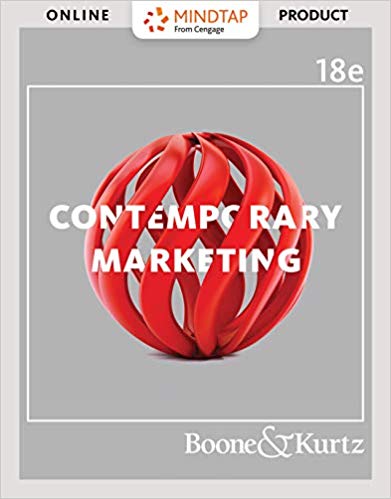This is completed downloadable of Test Bank for Contemporary Marketing 18th by Boone

Product Details:
- ISBN-10 : 0357033779
- ISBN-13 : 978-0357033777
- Author:
CONTEMPORARY MARKETING, 17th Edition, is the proven, premier teaching and learning resource for foundational marketing courses. The authors provide thorough coverage of essential marketing principles, exploring all components of the marketing mix, and providing practical guidance to help students prepare for successful marketing careers. This trusted product continues to grow stronger with each groundbreaking new edition, preserving what has made previous editions perennial best-sellers, while adding innovative new features and up-to-date information on current trends, topics, research, and best practices in this ever-evolving field.
Table of Content:
- PART 1 DESIGNING CUSTOMER-ORIENTED MARKETING STRATEGIES
- CHAPTER 1: MARKETING: THE ART AND SCIENCE OF SATISFYING CUSTOMERS
- What Is Marketing?
- Learning It: What Is Marketing?
- Closing Example
- Elements of Marketing Strategy
- Learning It: Elements of Marketing Strategy
- Marketing Mix Variables
- Closing Example
- Five Eras of Marketing History
- Learning It: Five Eras of Marketing History
- Closing Example
- From Transaction-Based Marketing to Relationship Marketing
- Learning It: From Transaction-Based Marketing to Relationship Marketing
- Closing Example
- Categories of Marketing
- Learning It: Categories of Marketing
- Closing Example
- Eight Functions of Marketing Physical Goods
- Learning It: Eight Functions of Marketing Physical Goods
- Closing Example
- Analyzing Marketing Strategy
- Learning It: Analyzing Marketing Strategy
- Learn It Today . . . Use It Tomorrow
- Chapter Summary
- Key Terms
- CHAPTER 2: STRATEGIC PLANNING IN CONTEMPORARY MARKETING
- Marketing Planning: The Basis for Strategy and Tactics
- Learning It: Marketing Planning: The Basis for Strategy and Tactics
- Closing Example
- Marketing Plan Components
- Learning It: Marketing Plan Components
- The Marketing Planning Process
- Closing Example
- Industry Structure and Competition
- Learning It: Industry Structure and Competition
- Closing Example
- SWOT Analysis
- Learning It: SWOT Analysis
- Closing Example
- Portfolio Analysis–A Planning Tool
- Learning It: Portfolio Analysis–A Planning Tool
- Closing Example
- Using SWOT Analysis and BCG Matrix
- Learning It: Using SWOT Analysis and BCG Matrix
- Conducting Portfolio Analysis
- Learn It Today . . . Use It Tomorrow
- Chapter Summary
- Key Terms
- CHAPTER 2: THE MARKETING ENVIRONMENT, ETHICS, AND SOCIAL RESPONSIBILITY
- The Marketing Environment
- Closing Example
- The Competitive Environment
- Closing Example
- The Political-Legal Environment
- Closing Example
- Types of Regulatory Forces
- Learning It: Types of Regulatory Forces
- Closing Example
- The Economic Environment
- Learning It: The Economic Environment
- Closing Example
- The Technological Environment
- Learning It: The Technological Environment
- Closing Example
- The Social-Cultural Environment
- Learning It: The Social-Cultural Environment
- Closing Example
- Ethical Issues in Marketing
- Learning It: Ethical Issues in Marketing
- Ethics in Product Strategy
- Ethics in Pricing
- Ethics in Distribution
- Ethics in Promotion
- Closing Example
- Social Responsibility
- Learning It: Social Responsibility
- Closing Example
- Learn It Today . . . Use It Tomorrow
- Chapter Summary
- Key Terms
- CHAPTER 4: E-BUSINESS: MANAGING THE CUSTOMER EXPERIENCE
- Opportunities Offered by Digital Marketing
- Learning It: Opportunities Offered by Digital Marketing
- Closing Example
- E-Business in the B2B Market
- Learning It: E-Business in the B2B Market
- Closing Example
- Benefits of Shopping Online
- Learning It: Benefits of Shopping Online
- Closing Example
- Challenges Faced by Online Marketers and Consumers
- Learning It: Challenges Faced by Online Marketers and Consumers
- Closing Example
- Factors That Influence E-Commerce Success
- Learning It: Factors That Influence E-Commerce Success
- User Experience
- Product Offering
- Checkout Process
- Revenue Maximization
- Closing Example
- Assessing the Effectiveness of an E-Commerce Site
- Learning It: Assessing the Effectiveness of an E-Commerce Site
- Closing Example
- Optimizing the Effectiveness of an E-Commerce Site
- Learning It: Optimizing the Effectiveness of an E-Commerce Site
- Learn It Today . . . Use It Tomorrow
- Chapter Summary
- Key Terms
- CHAPTER 5: SOCIAL MEDIA: LIVING IN THE CONNECTED WORLD
- What Is Social Media?
- Learning It: What Is Social Media?
- Closing Example
- Social Media Platforms
- Learning It: Social Media Platforms
- Closing Example
- How Consumers Use Social Media
- Learning It: How Consumers Use Social Media
- Closing Example
- Goals of a Social Media Marketing Campaign
- Learning It: Goals of a Social Media Marketing Campaign
- Closing Example
- Monitoring and Measuring Social Media Marketing
- Learning It: Monitoring and Measuring Social Media Marketing
- Closing Example
- Creating Effective Social Media Content
- Learning It: Creating Effective Social Media Content
- Closing Example
- Ethics in Social Media
- Learning It: Ethics in Social Media
- Closing Example
- Launching and Measuring a Social Media Campaign
- Learning It: Launching and Measuring a Social Media Campaign
- Learn It Today . . . Use It Tomorrow
- Chapter Summary
- Key Terms
- PART 2 UNDERSTANDING BUYERS AND MARKETS
- CHAPTER 6: CONSUMER BEHAVIOR
- Influences Affecting Consumer Behavior
- Learning It: Influences Affecting Consumer Behavior
- Closing Example
- The Consumer Decision Process
- Learning It: The Consumer Decision Process
- Closing Example
- How Involvement Level Affects Consumer Decisions
- Learning It: How Involvement Level Affects Consumer Decisions
- Consumer Decision Making Styles
- Closing Example
- Social Factors Influencing Consumer Behavior
- Learning It: Social Factors Influencing Consumer Behavior
- Closing Example
- Psychological Factors Influencing Consumer Behavior
- Learning It: Psychological Factors Influencing Consumer Behavior
- Closing Example
- Situational Factors Influencing Consumer Behavior
- Learning It: Situational Factors Influencing Consumer Behavior
- Closing Example
- Identifying Influences on Consumer Behavior
- Learning It: Identifying Influences on Consumer Behavior
- Learn It Today . . . Use It Tomorrow
- Chapter Summary
- Key Terms
- CHAPTER 7: BUSINESS MARKETS AND BUYING BEHAVIOR
- Nature of the Business Market
- Learning It: Nature of the Business Market
- Closing Example
- Categories of Business Markets
- Learning It: Categories of Business Markets
- Closing Example
- Segmenting B2B Markets
- Learning It: Segmenting B2B Markets
- Closing Example
- The Business Buying Process
- Learning It: The Business Buying Process
- Closing Example
- The Organizational Buying Process
- Learning It: The Organizational Buying Process
- Closing Example
- Buying Center Roles
- Learning It: Buying Center Roles
- Closing Example
- Learn It Today . . . Use It Tomorrow
- Chapter Summary
- Key Terms
- CHAPTER 8: GLOBAL MARKETING
- Global Marketing
- Learning It: Global Marketing
- Closing Example
- Multinational Economic Integration
- Learning It: Multinational Economic Integration
- Closing Example
- The International Marketing Environment
- Learning It: The International Marketing Environment
- Closing Example
- Strategies for Entering Foreign Markets
- Learning It: Strategies for Entering Foreign Markets
- International Direct Investment
- Closing Example
- Marketing Mix Strategies
- Learning It: Marketing Mix Strategies
- Closing Example
- Determining a Market Entry Strategy
- Learning It: Determining a Market Entry Strategy
- Learn It Today . . . Use It Tomorrow
- Chapter Summary
- Key Terms
- PART 3 TARGET MARKET SELECTION
- CHAPTER 9: MARKET SEGMENTATION, TARGETING, AND POSITIONING
- Types of Market
- Learning It: Types of Markets
- Closing Example
- Criteria for Effective Market Segmentation
- Learning It: Criteria for Effective Market Segmentation
- Closing Example
- Geographic Segmentation
- Learning It: Geographic Segmentation
- Closing Example
- Demographic Segmentation
- Learning It: Demographic Segmentation
- Closing Example
- Psychographic Segmentation
- Learning It: Psychographic Segmentation
- Closing Example
- Behavioral Segmentation
- Learning It: Behavioral Segmentation
- Closing Example
- Strategies for Reaching Target Markets
- Learning It: Strategies for Reaching Target Markets
- Closing Example
- Positioning Strategies and Value Propositions
- Learning It: Positioning Strategies and Value Propositions
- Closing Example
- Classifying Segmentation Variables
- Learning It: Classifying Segmentation Variables
- Learn It Today . . . Use It Tomorrow
- Chapter Summary
- Key Terms
- CHAPTER 10: MARKETING RESEARCH
- The Marketing Research Process
- Learning It: The Marketing Research Process
- Closing Example
- Secondary Data Collection
- Learning It: Secondary Data Collection
- Closing Example
- Primary Research Methods
- Learning It: Primary Research Methods
- Closing Example
- Conducting International Market Research
- Learning It: Conducting International Market Research
- Closing Example
- Technology in Marketing Research
- Learning It: Technology in Marketing Research
- Closing Example
- Classifying Data as Primary or Secondary
- Learning It: Classifying Data as Primary or Secondary
- Learn It Today . . . Use It Tomorrow
- Chapter Summary
- Key Terms
- PART 4 PRODUCT DECISIONS
- CHAPTER 11: PRODUCT AND BRANDING CONCEPTS
- What Are Goods and Services?
- Learning It: What Are Goods and Services?
- Goods–Services Continuum
- Closing Example
- Types of Consumer Products
- Learning It: Types of Consumer Products
- How the Marketing Mix Applies
- Closing Example
- Types of Business Products
- Learning It: Types of Business Products
- Closing Example
- Managing Brands for Competitive Advantage
- Learning It: Managing Brands for Competitive Advantage
- Brand Loyalty
- Brand Equity and Personality
- Closing Example
- Protecting Brand Identity
- Learning It: Protecting Brand Identity
- Closing Example
- Types of Brand Strategies
- Learning It: Types of Brand Strategies
- Brand Extension vs. Line Extension
- Closing Example
- Organizing Brands and Products
- Learning It: Organizing Brands and Products
- Organizing for New Product Development
- Closing Example
- Three Major Objectives of Packaging
- Learning It: Three Major Objectives of Packaging
- Labels
- Closing Example
- Learn It Today . . . Use It Tomorrow
- Chapter Summary
- Key Terms
- CHAPTER 12: DEVELOPING AND MANAGING PRODUCTS
- Strategies for New Product Development
- Learning It: Strategies for New Product Development
- Closing Example
- The New Product Development Process
- Learning It: The New Product Development Process
- Closing Example
- New Product Adoption
- Learning It: New Product Adoption
- The Diffusion Process
- Factors Affecting Rates of Adoption
- Closing Example
- The Product Lifecycle
- Learning It: The Product Lifecycle
- Closing Example
- Marketing Across the Product Lifecycle
- Learning It: Marketing Across the Product Lifecycle
- Extending the Product Lifecycle
- Closing Example
- The Product Mix
- Learning It: The Product Mix
- Managing the Product Mix
- Closing Example
- Quality as a Product Strategy
- Learning It: Quality as a Product Strategy
- Quality of Services
- Closing Example
- Learn It Today . . . Use It Tomorrow
- Chapter Summary
- Key Terms
- PART 5 PRICING DECISIONS
- CHAPTER 13: PRICING CONCEPTS
- Foundations of Pricing Strategy
- Learning It: Foundations of Pricing Strategy
- Closing Example
- Pricing Objectives
- Learning It: Pricing Objectives
- Closing Example
- Calculating Markup and Margin
- Learning It: Calculating Markup and Margin
- Closing Example
- Fixed and Variable Costs
- Learning It: Fixed and Variable Costs
- Closing Example
- Breakeven Analysis
- Learning It: Breakeven Analysis
- Closing Example
- The Cost-Volume-Profit Relationship
- Learning It: The Cost-Volume-Profit Relationship
- Closing Example
- Applying Breakeven Analysis
- Learning It: Applying Breakeven Analysis
- Learn It Today . . . Use It Tomorrow
- Chapter Summary
- Key Terms
- CHAPTER 14: PRICING STRATEGIES
- How Price Affects Demand
- Learning It: How Price Affects Demand
- Price Elasticity
- Closing Example
- Forecasting Demand
- Learning It: Forecasting Demand
- Closing Example
- Pricing Strategies
- Closing Example
- Pricing Tactics
- Learning It: Pricing Tactics
- Closing Example
- Price and Perception of Quality
- Learning It: Price and Perception of Quality
- Closing Example
- Pricing and the Law
- Learning It: Pricing and the Law
- Closing Example
- Learn It Today . . . Use It Tomorrow
- Chapter Summary
- Key Terms
- PART 6 DISTRIBUTION DECISIONS
- CHAPTER 15: DISTRIBUTION CHANNELS AND SUPPLY CHAIN MANAGEMENT
- What Are the Four Distribution Channels?
- Learning It: What Are the Four Distribution Channels?
- Types of Distribution Channels
- Closing Example
- Functions of Intermediaries
- Learning It: Functions of Intermediaries
- Short and Long Distribution Channels
- Closing Example
- Selecting Distribution Channels
- Learning It: Selecting Distribution Channels
- Closing Example
- Components of the Supply Chain
- Learning It: Components of the Supply Chain
- Managing the Supply Chain
- Closing Example
- Key Priorities of Warehousing and Storage
- Learning It: Key Priorities of Warehousing and Storage
- Closing Example
- Modes of Transportation
- Learning It: Modes of Transportation
- Comparing the Five Modes of –Transport
- Closing Example
- Accomplishing the Priorities of a Supply Chain
- Learning It: Accomplishing the Priorities of a Supply Chain
- Learn It Today . . . Use It Tomorrow
- Chapter Summary
- Key Terms
- CHAPTER 16 RETAILING AND DIRECT MARKETING
- Retailing in the United States
- Learning It: Retailing in the United States
- Closing Example
- Retailing Strategy
- Learning It: Retailing Strategy
- Closing Example
- Strategic Considerations for Retail Strategy
- Learning It: Strategic Considerations for Retail Strategy
- Closing Example
- Categorizing Retailers
- Learning It: Categorizing Retailers
- Closing Example
- Direct Marketing and Nonstore Retailing
- Learning It: Direct Marketing and Nonstore Retailing
- Closing Example
- Determining an Effective Retail Strategy for Manufacturers
- Learning It: Determining an Effective Retail Strategy for Manufacturers
- Learn It Today . . . Use It Tomorrow
- Chapter Summary
- Key Terms
- PART 7 PROMOTIONAL DECISIONS
- CHAPTER 17 INTEGRATED MARKETING COMMUNICATIONS, ADVERTISING, AND PUBLIC RELATIONS
- Integrated Marketing Communications
- Learning It: Integrated Marketing Communications
- Elements of the Promotional Mix
- Variants of the Promotion Mix
- Closing Example
- The Communication Process
- Learning It: The Communication Process
- The AIDA Concept
- Closing Example
- The Objectives of Promotion
- Learning It: The Objectives of Promotion
- Closing Example
- Advertising Appeals
- Learning It: Advertising Appeals
- Closing Example
- Media Selection and Scheduling
- Learning It: Media Selection and Scheduling
- Closing Example
- Public Relations
- Learning It: Public Relations
- Ethics and PR
- Closing Example
- Promotional Mix Effectiveness
- Learning It: Promotional Mix Effectiveness
- Closing Example
- Learn It Today . . . Use It Tomorrow
- Chapter Summary
- Key Terms
- CHAPTER 18 PERSONAL SELLING AND SALES PROMOTION
- Personal Selling
- Learning It: Personal Selling
- Closing Example
- The Four Sales Channels
- Learning It: The Four Sales Channels
- Closing Example
- The Sales Process and AIDA Concept
- Learning It: The Sales Process and AIDA Concept
- Closing Example
- The Sales Process
- Learning It: The Sales Process
- Closing Example
- Sales Management Functions
- Learning It: Sales Management Functions
- Ethical and Legal Issues in Sales
- Closing Example
- Sales Promotion
- Learning It: Sales Promotion
- Closing Example
- Effective Promotional Tactics
- Learning It: Effective Promotional Tactics
- Learn It Today . . . Use It Tomorrow
- Chapter Summary
- Key Terms
- APPENDIX A: DEVELOPING AN EFFECTIVE MARKETING PLAN
- APPENDIX B: FINANCIAL ANALYSIS IN MARKETING
- Notes
- Glossary
- Name & Company Index
- Subject Index





